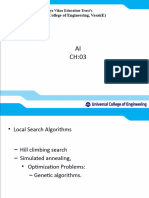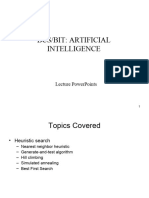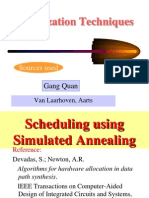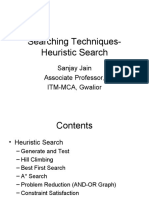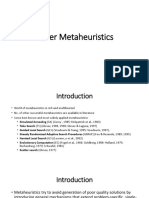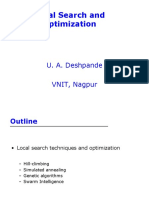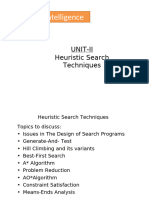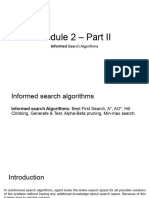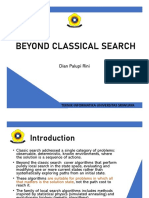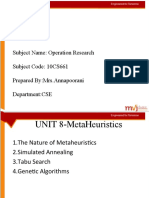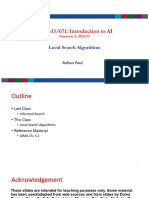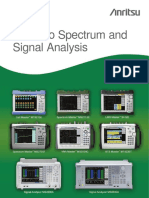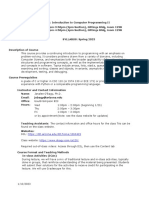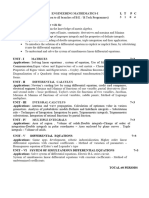0 ratings0% found this document useful (0 votes)
7 viewsAI Module 3 Partial
AI Module 3 Partial
Uploaded by
saiyaswin2004The document discusses various search algorithms for complex environments, including local search algorithms and systematic algorithms. Local search algorithms like hill climbing, simulated annealing, and local beam search use iterative improvement to explore neighborhoods of solutions and may converge to local optima. Systematic algorithms are characterized by observable, deterministic, and known environments where the solution is a sequence of actions. The document provides details on different local search techniques, explaining concepts like hill climbing, simulated annealing, and local beam search.
Copyright:
© All Rights Reserved
Available Formats
Download as PDF, TXT or read online from Scribd
AI Module 3 Partial
AI Module 3 Partial
Uploaded by
saiyaswin20040 ratings0% found this document useful (0 votes)
7 views29 pagesThe document discusses various search algorithms for complex environments, including local search algorithms and systematic algorithms. Local search algorithms like hill climbing, simulated annealing, and local beam search use iterative improvement to explore neighborhoods of solutions and may converge to local optima. Systematic algorithms are characterized by observable, deterministic, and known environments where the solution is a sequence of actions. The document provides details on different local search techniques, explaining concepts like hill climbing, simulated annealing, and local beam search.
Original Description:
based on local search
Original Title
AI-Module-3-Partial
Copyright
© © All Rights Reserved
Available Formats
PDF, TXT or read online from Scribd
Share this document
Did you find this document useful?
Is this content inappropriate?
The document discusses various search algorithms for complex environments, including local search algorithms and systematic algorithms. Local search algorithms like hill climbing, simulated annealing, and local beam search use iterative improvement to explore neighborhoods of solutions and may converge to local optima. Systematic algorithms are characterized by observable, deterministic, and known environments where the solution is a sequence of actions. The document provides details on different local search techniques, explaining concepts like hill climbing, simulated annealing, and local beam search.
Copyright:
© All Rights Reserved
Available Formats
Download as PDF, TXT or read online from Scribd
Download as pdf or txt
0 ratings0% found this document useful (0 votes)
7 views29 pagesAI Module 3 Partial
AI Module 3 Partial
Uploaded by
saiyaswin2004The document discusses various search algorithms for complex environments, including local search algorithms and systematic algorithms. Local search algorithms like hill climbing, simulated annealing, and local beam search use iterative improvement to explore neighborhoods of solutions and may converge to local optima. Systematic algorithms are characterized by observable, deterministic, and known environments where the solution is a sequence of actions. The document provides details on different local search techniques, explaining concepts like hill climbing, simulated annealing, and local beam search.
Copyright:
© All Rights Reserved
Available Formats
Download as PDF, TXT or read online from Scribd
Download as pdf or txt
You are on page 1of 29
SEARCH IN COMPLEX
ENVIRONMENTS
(Slides are based on Artificial
Intelligence A Modern Approach by
Stuart Russell & Peter Norvig)
Dr. K. Venkateswara Rao
Professor CSE
Contents
• Local search algorithms and optimization problems
– Hill-climbing search
– Simulated annealing
– Local beam search
– Evolutionary algorithms
• Optimal decisions in games
– The minimax search algorithm
– Optimal decisions in multiplayer games
• Alpha-Beta pruning
– Move ordering
• Monte Carlo tree search
• Kalman Filter
Systematic Algorithms
• Systematic Algorithms are characterized by Observable,
deterministic, known environments where solution (goal
configuration) and path (a sequence of actions) to the goal are
important.
• Observable: In an observable environment, the agent (the
entity trying to solve the problem) can directly observe the
current state of the environment. This means that the agent
has complete information about the state of the environment
at any given time.
• Deterministic: In a deterministic environment, the outcome
of an action is fully determined by the current state of the
environment and the action taken by the agent. There is no
randomness or uncertainty in the environment's response to
the agent's actions.
Systematic Algorithms
• Known: In a known environment, the agent has complete
knowledge of the environment's rules and dynamics. There
are no hidden states or unknown elements in the
environment.
• Solution as a sequence of actions: In such environments, the
solution to a problem is typically represented as a sequence
of actions that the agent can take to transition from the initial
state of the environment to the goal state.
• Local search, on the other hand, is a problem-solving
technique used in optimization and search problems. It differs
from the scenario (characterized by Observable,
deterministic, known environments where a solution is a
sequence of actions ) described above in several ways
Local Search
• Local search is an optimization technique used in artificial
intelligence to find solutions to problems by iteratively exploring
the space of possible solutions, focusing on improving the current
solution by making small incremental changes.
• It is particularly useful for problems where the search space is
large and it is impractical to explore all possible solutions.
• Characteristics of local search algorithms
1. Iterative Improvement
2. Exploration of Neighborhoods
3. No Backtracking
4. Heuristic Guidance
5. Stochastic or Deterministic
6. Convergence to Local Optima
Local Search
• Local search algorithms start with an initial solution and
iteratively explore the neighborhood of the current
solution by applying small changes to the current
solution.
• At each iteration, the algorithm evaluates neighboring
solutions and selects the one that offers the most
improvement according to some evaluation function or
objective.
• Local search algorithms often use heuristic information
to guide the search process.
• One of the main limitations of local search algorithms is
that they may converge to local optima, solutions that are
locally optimal but not globally optimal.
Local Search
• Local search algorithms do not backtrack.
– They only move forward by considering neighboring
solutions and selecting the one that offers the most
improvement. This can make them more efficient in large
search spaces but also means they may get stuck in local
optima.
• Local search algorithms can be stochastic or deterministic.
– Stochastic algorithms introduce randomness into the
search process, which can help escape local optima and
explore a broader range of solutions.
– Deterministic algorithms, on the other hand, follow a fixed
set of rules for selecting neighboring solutions and may be
more predictable in their behavior.
Local Search
• Local Search Algorithms are not Systematic. The path
followed by the agent is not retained. Two key
advantages of local search algorithms are:
1. They use very little memory, usually constant.
2. They can often find reasonable solutions in large or
infinite search spaces
• A state space landscape has both location (defined by
state), and elevation (defined by value of the heuristic
cost function (if aim is to find global minimum) or
objective function (if aim is to find global maximum)).
• A complete local search algorithm always finds a goal if
one exists
Local Search Algorithms
1. Hill-climbing search
2. Simulated Annealing
3. Local beam search
4. Evolutionary algorithms
Hill Climbing Search
Hill-Climbing Search
Steepest-Ascent Hill Climbing
• current start node
• loop do
– neighbor a highest-valued successor of current
– if neighbor.Value <= current.Value then return current.State
– current neighbor
• end loop
Hill-Climbing Example & Problems
Local Search – Hill Climbing
Ridges Illustration
Variants of Hill Climbing
• Allow backtracking
• Stochastic hill climbing: choose at random from among
the uphill moves. The probability of selection varies
with the steepness of the uphill move. This usually
converges more slowly than steepest ascent.
• First-choice hill climbing: implements stochastic hill
climbing by generating successors randomly until one is
generated that is better than the current state.
• Random restart hill climbing: “If at first you don’t
succeed, try, try again.” It conducts a series of hill-
climbing searches from randomly generated initial states,
until a goal is found.
Simulated Annealing
• Hill-climbing is incomplete
• Pure random walk, keeping track of the best state found
so far, is complete but very inefficient because it relies
solely on random moves without any intelligent
guidance
• Simulated Annealing is a Variant of hill climbing that
Combines hill climbing with random walk in some way
to yield both efficient and completeness.
• Simulated Annealing comes from the physical process of
annealing that is used to temper or harden metals and
glass by heating them to a high temperature / high energy
levels and then gradually cooling them, thus allowing the
material to reach a low energy crystalline state.
Simulated Annealing
Simulated Annealing Algorithm
• Initialize: Start with an initial solution to the optimization problem.
• Define Temperature Schedule: The algorithm requires a cooling schedule,
which determines how the temperature decreases over time. Initially, the
temperature is high, allowing for more exploration of the solution space, and then
it gradually decreases to focus more on exploitation.
• Iterate: Perform a series of iterations, each consisting of the following steps:
1. Generate a Neighbor
2. Evaluate Neighbor
3. Accept or Reject Neighbor: Compare the cost of the new solution with the
cost of the current solution. If the new solution is better (i.e., has a lower
cost), accept it. If the new solution is worse, accept it with a certain
probability, which depends on the temperature and the difference in cost
between the current and new solutions. This probabilistic acceptance allows
the algorithm to escape local optima.
4. Update Temperature: Adjust the temperature according to the cooling
schedule.
• Termination: Repeat the iterations until a stopping criterion is met. This could be
a maximum number of iterations, reaching a certain temperature threshold, or
finding a solution that meets some desired criteria.
Simulated Annealing
The probability of moving to a higher energy state, instead of lower is
p = e^(-E/kT)
where E is the positive change in energy level, T is the temperature,
and k is Bolzmann’s constant.
At the beginning, the temperature is high. As the temperature becomes
lower
kT becomes lower
E/kT gets bigger
(-E/kT) gets smaller
e^(-E/kT) gets smaller
As the process continues, the probability of a downhill move gets
smaller and smaller.
Simulated Annealing Algorithm
• current start node; /* Initial state of the problem (input) */
• for each T on the schedule /* need a schedule (input) */
1. next randomly selected successor of current
2. evaluate next; if it’s a goal, return it
3. E next.Value – current.Value /* already negated */
4. if E > 0
then current next /* better than current */
else current next with probability e^(E/T)
• E represents the change in the value of the objective function.
• Since the physical relationships no longer apply, drop k. So p =
e^(-E/T)
• We need an annealing schedule, which is a sequence of values of
T: T0, T1, T2, ...
Simulated Annealing
Simulated Annealing Applications
• Basic Problems
– Traveling salesman
– Graph partitioning
– Matching problems
– Graph coloring
– Scheduling
• Engineering
– VLSI design
• Placement
• Routing
• Array logic minimization
• Layout
– Facilities layout
– Image processing
– Code design in information theory
Local Beam Search Technique
Local Beam Search Algorithm
1. Initialization: Start with k randomly generated initial solutions or paths, where
k is the beam width or the number of beams. K is an input to the algorithm.
2. Expansion: For each beam, generate successor solutions by applying possible
operators or actions. These successor solutions represent neighboring states in
the search space.
3. Evaluation: Evaluate the quality of each successor solution using a heuristic or
objective function. This function measures how close a solution is to the
desired goal or optimal solution. If any one is a goal, return solution (algorithm
halts).
4. Selection: Select the top k successor solutions across all beams based on their
evaluation scores. These top k solutions become the new set of beams for the
next iteration.
5. Termination: Repeat steps 2-4 until a termination condition is met. This could
be a maximum number of iterations, reaching a certain quality threshold, or
finding a solution that satisfies specific criteria.
6. Result: Once the termination condition is satisfied, return the best solution
found among all beams.
Local Beam Search Characteristics
• Parallel Exploration: Local Beam Search explores multiple paths
simultaneously by maintaining multiple beams. This parallel exploration can
help the algorithm to avoid getting stuck in local optima and increase the
chances of finding a good solution.
• Beam Selection: At each iteration, only the top k successor solutions are
selected to become the new set of beams. This selective mechanism helps to
focus the search on the most promising regions of the search space.
• Diversity: Since Local Beam Search maintains multiple beams, it can explore
different regions of the search space concurrently. This diversity in exploration
can be beneficial for finding a variety of solutions or for escaping local optima.
• Stochastic beam search: Instead of choosing the k best nodes from he pool of
candidate successors, stochastic beam search chooses k successors, with
probability of choosing a given successor being increasing function of its value
• Stochastic beam search resembles to a process of natural selection: The
successors (offspring) of a state (organism) populate the next generation
according to its value (fitness).
Genetic Algorithms
• Variant of stochastic beam search
• Combines two parent states to generate successors
• Uses one fitness function and two operators called Crossover and
Mutation.
• Start with random population of states
– Representation serialized (ie. strings of characters or bits)
– States are ranked with “fitness function”
• Produce new generation
– Select random pair(s) using probability:
• probability ~ fitness
– Randomly choose “crossover point”
• Offspring mix halves
– Randomly mutate bits
Genetic Algorithm
Genetic Algorithm
You might also like
- Old School Hex Crawling HacksDocument50 pagesOld School Hex Crawling HacksNever disco75% (4)
- Motivational Letter For MBADocument1 pageMotivational Letter For MBABojan Boricic0% (1)
- Manual CDR500 PDFDocument18 pagesManual CDR500 PDFDan Marius100% (1)
- 3 4optimizationDocument52 pages3 4optimizationashish.rawatNo ratings yet
- Bcs Lecture1 Part2 2023Document27 pagesBcs Lecture1 Part2 2023ISAAC SICHALWENo ratings yet
- WS2122 UNIT-2 - AItDocument84 pagesWS2122 UNIT-2 - AItpavanithakkellapalliNo ratings yet
- Searching AlgorithmDocument45 pagesSearching AlgorithmKartik Pagariya.No ratings yet
- Co 4Document56 pagesCo 4Gaddam YakeshreddyNo ratings yet
- Optimization Techniques: Sources UsedDocument54 pagesOptimization Techniques: Sources UsedPrasanth ShivanandamNo ratings yet
- Hill Climbing ALgorithmDocument19 pagesHill Climbing ALgorithmVikash YadavNo ratings yet
- Artificial Intelligence: Informed SearchDocument19 pagesArtificial Intelligence: Informed SearchalokchoudhuryNo ratings yet
- Inform Search Chapter4 3 6Document8 pagesInform Search Chapter4 3 6vaghelamiralNo ratings yet
- AI Lab Assignmentc7Document5 pagesAI Lab Assignmentc7Sagar PrasadNo ratings yet
- UNIT3 AiDocument11 pagesUNIT3 AiimproveyourselfmabNo ratings yet
- Hill Climbing AlgoDocument27 pagesHill Climbing Algonmmishra77No ratings yet
- 8 Informed Search -Hill climbingDocument16 pages8 Informed Search -Hill climbingMythily GaneshNo ratings yet
- Searching Techniques-Heuristic Search: Sanjay Jain Associate Professor, ITM-MCA, GwaliorDocument54 pagesSearching Techniques-Heuristic Search: Sanjay Jain Associate Professor, ITM-MCA, GwaliorSanjay JainNo ratings yet
- Other MetaheuristicsDocument31 pagesOther MetaheuristicsLakshya KarwaNo ratings yet
- AI Beyond Classical Search &CSPsDocument116 pagesAI Beyond Classical Search &CSPsshailaja.mNo ratings yet
- Unit 2Document8 pagesUnit 2kaifali532No ratings yet
- Hill ClimbingDocument17 pagesHill Climbingwevem43603No ratings yet
- Module 3 Probem SolvingDocument64 pagesModule 3 Probem Solvingafrozbhati1111No ratings yet
- AI Search STDDocument127 pagesAI Search STDYogesh KumbhalkarNo ratings yet
- Artificial Intelligence: Beyond Classical SearchDocument29 pagesArtificial Intelligence: Beyond Classical SearchPrasidha PrabhuNo ratings yet
- Unit-2 AiDocument119 pagesUnit-2 Ai2111cs030057No ratings yet
- Ai HFDocument15 pagesAi HFjimmi481No ratings yet
- Introduction To Genetic Algorithms (GA)Document46 pagesIntroduction To Genetic Algorithms (GA)Saksham RawatNo ratings yet
- Local Search Algos - Hill Climbing Simulated Anesaling Beam Search AlgosDocument31 pagesLocal Search Algos - Hill Climbing Simulated Anesaling Beam Search AlgostusharNo ratings yet
- Heuristic Search TechniquesDocument75 pagesHeuristic Search TechniquesAparna PanyaNo ratings yet
- Heuristic SearchDocument44 pagesHeuristic SearchVighneshwarMadasNo ratings yet
- 07 Local SearchDocument31 pages07 Local SearchthebinarycodingNo ratings yet
- Uad Local Search Opt Final-1Document35 pagesUad Local Search Opt Final-1PrashantyelekarNo ratings yet
- Problem Graphs Matching Hill ClimbingDocument32 pagesProblem Graphs Matching Hill ClimbingRaghu SomuNo ratings yet
- Unit-2Document72 pagesUnit-2tejaswinichinipilliNo ratings yet
- Unit-5Document52 pagesUnit-5sksharma3058No ratings yet
- AI Assignment 2 Q and ADocument7 pagesAI Assignment 2 Q and AChinmay JoshiNo ratings yet
- Informed SearchDocument25 pagesInformed SearchmonacmicsiaNo ratings yet
- Unit 2Document66 pagesUnit 2meghanaghogareNo ratings yet
- Unit 2 - AiaDocument15 pagesUnit 2 - AiaPadmanabhan .sNo ratings yet
- Lecture 18Document53 pagesLecture 18IndoBoruto OfficialNo ratings yet
- Introduction To AI - Mod 2 Part 2Document37 pagesIntroduction To AI - Mod 2 Part 21GA22IS138Sanjay K. S.No ratings yet
- Module - 1 Lecture Notes - 4 Classical and Advanced Techniques For OptimizationDocument4 pagesModule - 1 Lecture Notes - 4 Classical and Advanced Techniques For OptimizationnnernNo ratings yet
- Ai PPT Un It 2Document60 pagesAi PPT Un It 2sarika satyaNo ratings yet
- Unit 2 Part 1Document30 pagesUnit 2 Part 1abhinav vuppalaNo ratings yet
- Local Search and OptimizationDocument28 pagesLocal Search and OptimizationMazharulislamNo ratings yet
- NIOT-UnitII-HillClimbing - and-SADocument6 pagesNIOT-UnitII-HillClimbing - and-SArt.cseNo ratings yet
- Unit-2.3 Local Search Algo and Optimization ProblemsDocument18 pagesUnit-2.3 Local Search Algo and Optimization Problemsmani111111No ratings yet
- CCATPREPARATION AI Module 3Document13 pagesCCATPREPARATION AI Module 3Vaishnavi GuravNo ratings yet
- 2. Unit-2 Heuristic Search TechniquesDocument56 pages2. Unit-2 Heuristic Search Techniquesakshayakeerthi1104No ratings yet
- SimulatedAnnealing pdfDocument26 pagesSimulatedAnnealing pdfMurilo De JesusNo ratings yet
- BlockDocument14 pagesBlockMai VanNo ratings yet
- CACS201 Unit 11 - AlgorithmsDocument12 pagesCACS201 Unit 11 - AlgorithmsMizash KandelNo ratings yet
- Materi AI-006Document27 pagesMateri AI-006niferli julienNo ratings yet
- Se 7204 Big Data Analysis Unit III Final 20.4.2017Document86 pagesSe 7204 Big Data Analysis Unit III Final 20.4.2017Dr.A.R.KavithaNo ratings yet
- Subject Name: Operation Research Subject Code: 10CS661 Prepared By:Mrs - Annapoorani Department:CSEDocument30 pagesSubject Name: Operation Research Subject Code: 10CS661 Prepared By:Mrs - Annapoorani Department:CSEAnnisa RahmawatyNo ratings yet
- Hill ClimbingDocument12 pagesHill ClimbingVishesh YadavNo ratings yet
- L05 Local Search AlgorithmsDocument21 pagesL05 Local Search AlgorithmsarabickathuNo ratings yet
- HillDocument15 pagesHillahmedliet143No ratings yet
- We Will See A Different Form of Heuristic Search AppliedDocument17 pagesWe Will See A Different Form of Heuristic Search AppliedahsanulmNo ratings yet
- III It Ci Unit 1Document28 pagesIII It Ci Unit 15049 preethi BaskaranNo ratings yet
- Dell PowerStore Networking Guide for PowerStore T Models stepsDocument21 pagesDell PowerStore Networking Guide for PowerStore T Models stepsanbuvenkatesh.tkNo ratings yet
- Guide To Signal Spectrum AnalysisDocument56 pagesGuide To Signal Spectrum AnalysishughespbrenNo ratings yet
- cs120 SyllabusDocument11 pagescs120 SyllabusStarlla WzwNo ratings yet
- Sample Beam Quantity Take OffDocument1 pageSample Beam Quantity Take OffJhulleanne BahandiNo ratings yet
- Bamboo CatalogueDocument72 pagesBamboo CataloguediartoNo ratings yet
- Engineering Mathematics - IDocument2 pagesEngineering Mathematics - IKalaiarasi RajaNo ratings yet
- The Oxford Companion To WinePDF - Harding, Julia Robinson OBE Mncis Thomas, Tara Q. & Jancis Robinson OBE MW & Tara Q. ThomasDocument4,061 pagesThe Oxford Companion To WinePDF - Harding, Julia Robinson OBE Mncis Thomas, Tara Q. & Jancis Robinson OBE MW & Tara Q. ThomasSergio Boggero100% (2)
- AIG Hedge Fund Start-Up ChecklistDocument4 pagesAIG Hedge Fund Start-Up ChecklistWilde RosnyNo ratings yet
- AadhaarDocument1 pageAadhaarstMary DigiNo ratings yet
- OUTLINE of SCIENCE TopicsDocument7 pagesOUTLINE of SCIENCE TopicsLeelee the GreatNo ratings yet
- ICTDBS502: Design A DatabaseDocument41 pagesICTDBS502: Design A DatabaseaarushNo ratings yet
- Piping Diagram For Chlorine Injection System: Intake BaysDocument1 pagePiping Diagram For Chlorine Injection System: Intake BaysRaja Prathap SinghNo ratings yet
- TDS of Top CoatDocument7 pagesTDS of Top Coatedm 60yNo ratings yet
- Wowza Media Server - UsersGuideDocument96 pagesWowza Media Server - UsersGuidepoopooheadmeNo ratings yet
- Econ Dev AssignDocument2 pagesEcon Dev AssignFav TangonanNo ratings yet
- Chapter 2 Mathematical Modeling of Dynamic SystemDocument56 pagesChapter 2 Mathematical Modeling of Dynamic SystemAmanuel AsfawNo ratings yet
- Chapter 13 PDFDocument34 pagesChapter 13 PDFAnubhav ShahNo ratings yet
- BogeDocument7 pagesBogeWage KarsanaNo ratings yet
- Java Compleated Assignment PDFDocument186 pagesJava Compleated Assignment PDFSammyNo ratings yet
- Direct-Link USB100PFBDocument2 pagesDirect-Link USB100PFBOmar Alfredo Del Castillo QuispeNo ratings yet
- 2 Components of CurriculumDocument13 pages2 Components of Curriculumngaruiyasamuel374No ratings yet
- 11th Standard - 1st Revision Test 2022 - Time Table DownloadDocument2 pages11th Standard - 1st Revision Test 2022 - Time Table DownloadVanitha KumarNo ratings yet
- Case Presentation For Blount's Disease B Proximal TibiaDocument43 pagesCase Presentation For Blount's Disease B Proximal TibiaCzarinah Joyce Novencido0% (1)
- WLL-LS1EnglishJHS-Q3W4M5L2-I Therefore ConcludeDocument3 pagesWLL-LS1EnglishJHS-Q3W4M5L2-I Therefore ConcludeAlhena ValloNo ratings yet
- Kokoi GR 9 ManualDocument69 pagesKokoi GR 9 ManualMmakgabo MmolaNo ratings yet
- Private Static IP Service With Site To Site VPN: Scenario 02Document1 pagePrivate Static IP Service With Site To Site VPN: Scenario 02Juan Pablo PaolilloNo ratings yet
- CimDocument60 pagesCimkanchhedwaNo ratings yet



